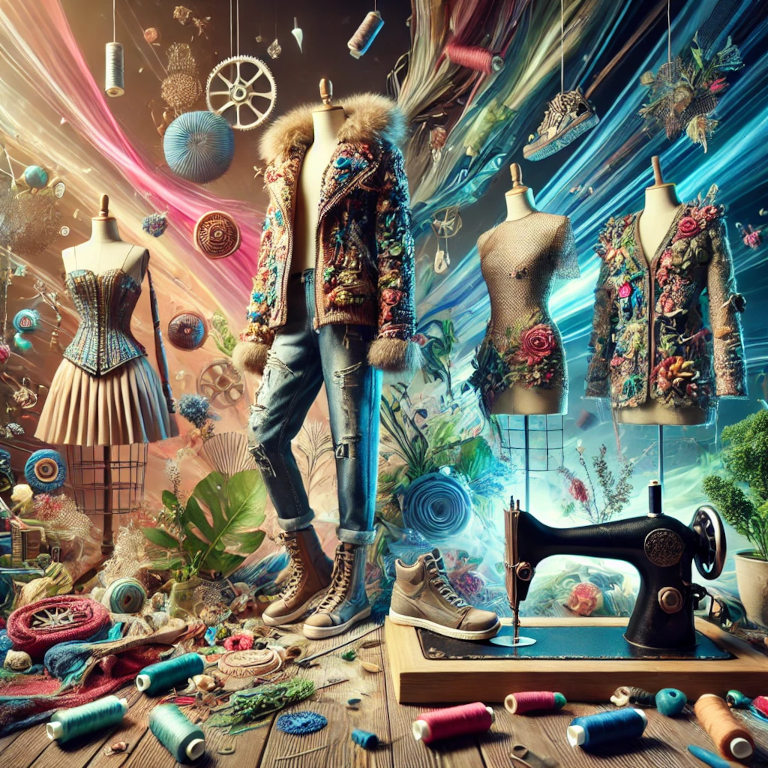In the ever-evolving world of fashion, upcycled fashion has emerged as a sustainable and innovative trend that transforms waste materials into stylish, unique clothing. Upcycling not only promotes environmental responsibility but also offers a fresh perspective on creativity and individuality in fashion. As an expert in Fashion and Beauty, I will delve into the concept of upcycled fashion, its benefits, and how it is reshaping the industry.
Understanding Upcycled Fashion
Upcycled fashion involves taking discarded or unused materials and transforming them into new, high-quality products. This process differs from recycling, which breaks down materials to create new products. Upcycling maintains the integrity of the original material, giving it a second life in a new form. This approach reduces waste, conserves resources, and offers a sustainable alternative to traditional fashion practices.
The Importance of Upcycled Fashion
- Environmental Benefits: The fashion industry is one of the largest contributors to global pollution, with textile waste and chemical runoff causing significant environmental harm. Upcycled fashion addresses these issues by reducing waste and minimizing the demand for new materials. This conservation of resources helps decrease the industry’s carbon footprint and promotes a more sustainable future.
- Unique and Creative Designs: Upcycled fashion allows designers to create one-of-a-kind pieces that stand out in a market saturated with mass-produced clothing. By repurposing materials, designers can experiment with textures, patterns, and styles that are not typically found in conventional fashion. This creativity leads to innovative designs that appeal to fashion-forward consumers.
- Economic Benefits: Upcycled fashion can be more cost-effective for both designers and consumers. Using existing materials reduces production costs, allowing designers to offer unique products at competitive prices. Additionally, consumers can find high-quality, affordable fashion that aligns with their values of sustainability and individuality.
- Promoting Ethical Practices: Upcycled fashion supports ethical fashion practices by encouraging transparency and accountability in the supply chain. Consumers are becoming increasingly aware of the social and environmental impact of their purchases, and upcycled fashion offers a way to support brands that prioritize sustainability and ethical production.
Key Players in Upcycled Fashion
- Independent Designers: Many independent designers and small brands have embraced upcycling as a core part of their business model. These designers often work with local artisans and use locally sourced materials to create unique, sustainable fashion.
- Established Brands: Some established fashion brands are incorporating upcycled collections into their product lines. By integrating upcycled fashion, these brands can appeal to environmentally conscious consumers and demonstrate their commitment to sustainability.
- Collaborative Projects: Collaborations between designers, artists, and environmental organizations have led to innovative upcycled fashion projects. These collaborations often raise awareness about sustainability issues and showcase the potential of upcycled fashion.
How to Incorporate Upcycled Fashion into Your Wardrobe
- DIY Projects: Upcycling old clothes at home is a fun and creative way to refresh your wardrobe. Simple projects like turning old jeans into shorts or adding patches to a jacket can give new life to items you already own.
- Support Upcycled Brands: Look for brands that specialize in upcycled fashion or offer upcycled collections. Supporting these brands helps promote sustainable fashion practices and encourages more companies to adopt similar approaches.
- Thrift Shopping: Thrift stores and vintage shops are excellent places to find unique pieces that can be upcycled. By purchasing second-hand clothing, you are reducing waste and supporting a circular fashion economy.
- Custom Alterations: Work with a tailor or seamstress to upcycle items in your wardrobe. Custom alterations can transform outdated or ill-fitting clothes into stylish, personalized pieces.
- Educate Yourself: Stay informed about sustainable fashion and upcycling trends. Follow fashion blogs, attend workshops, and engage with communities that focus on sustainable fashion to learn new techniques and ideas.
The Future of Upcycled Fashion
The future of upcycled fashion looks promising as more consumers and brands recognize the importance of sustainability. Technological advancements in textile production and innovative design approaches are expected to further enhance the potential of upcycled fashion. As awareness grows, the demand for sustainable and ethically produced fashion will continue to rise, driving positive change in the industry.
Summary
Upcycled fashion is revolutionizing the fashion industry by promoting sustainability, creativity, and ethical practices. By transforming waste materials into stylish, high-quality clothing, upcycled fashion reduces environmental impact and offers unique, innovative designs. Embracing upcycled fashion in your wardrobe not only supports sustainable practices but also allows you to express your individuality. As the movement gains momentum, upcycled fashion is set to become a cornerstone of a more sustainable and responsible fashion industry.






